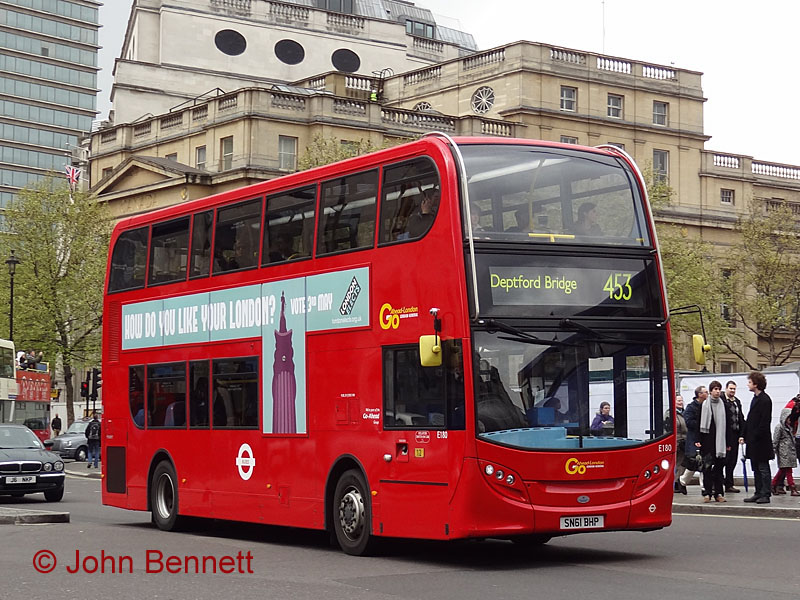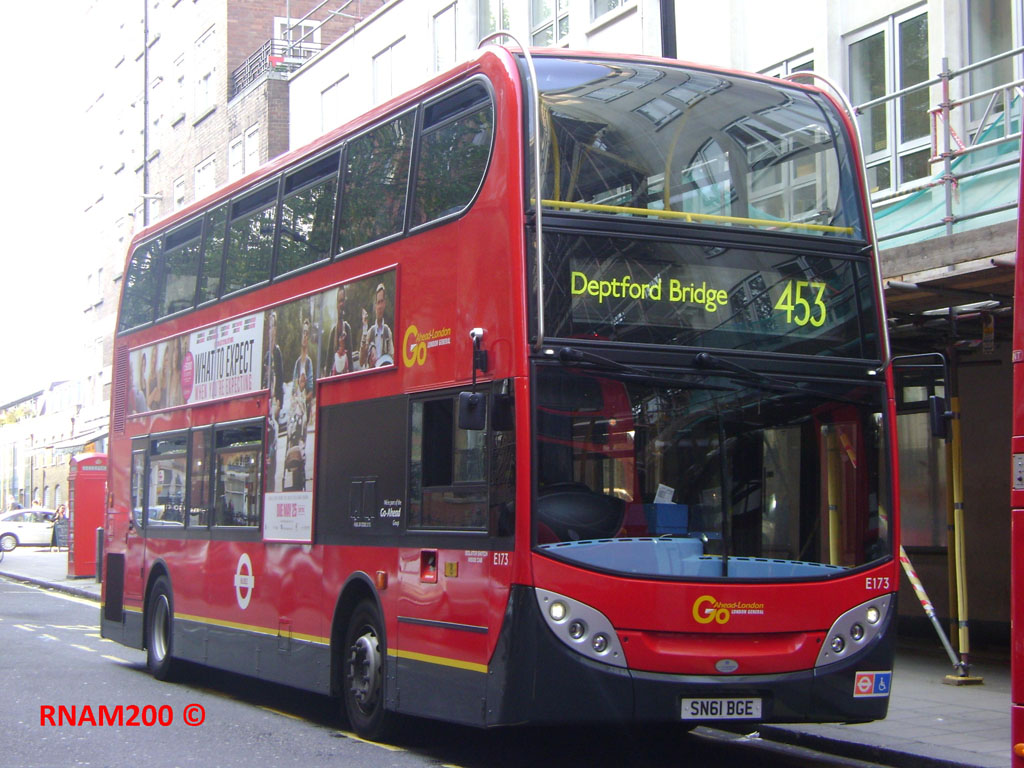 | Photo © Rhys Daniel. |
Home | Bus routes | Operational details | Service changes | Operators & Garages | Photo gallery
The 453 was formed from the trunk route 53 on 15 February 2003, the weekend that the central London congestion charge began. The 53, traditionally Plumstead Common to West Hampstead, later Camden Town, and until recently Oxford Circus, was cut back to Whitehall and reduced in frequency. The 453 operates from Deptford to Oxford Circus over the same route, and then on to Marylebone, but despite effectively being a split off of part of route 53, the new route was tendered, but was awarded to Stagecoach from Plumstead garage, which operated the 53.
The route was specified for Citaro Gs, known as “Bendy Buses,” although standard double deckers had to be used for the first four weeks as Mercedes could not deliver enough in time. This was the second of the “bendy bus” routes to operate outside Zone 1 (after the 436; the 507 and 521 were the first Bendy Buses, operating from 5 June 2002).
However, the route generated above usual interest when it became the first and indeed only artic route to be tendered and awarded to a different operator. This potentially created a problem for Selkent, which had lost its only artic operated route. As with other companies, the drivers selected to drive these large vehicles were put on preferable pay and conditions. The route loss meant they either had to go back onto standard bus work (whether or not retaining their enhanced pay), or transfer to the new operator.
The contract change also prompted the first order for new artics for over two years. The last artic conversion was of route 29 in January 2006, which more-or-less completed the list of obvious routes for the type. The vehicles were leased, so Selkent did not have the problem of disposing of them – some were used for much needed frequency increases on other artic routes. The new vehicles were the first, and again only, Euro 5 engined Citaros in London – previous examples were Euro 3, which is no longer allowed under emissions regulations. Some cosmetic changes had also been made to the design, most notably inside and around the rear end.
However, the second batch of Citaros on the route was to prove even more short-lived, as London gained a new Mayor shortly afterwards with a stated policy of removing all the artics before the end of 2011 – less than four years. In most cases this was straightforward as the original 5 or 7 year contract terms were due for renewal in any case. Only the 436 and 453 had gone onto second terms, and these were tendered early after just three years using a standard no-fault break clause in the contracts.
Go-Ahead retained both routes. It had been intended to close Mandela Way garage, from which the 453 operated, and move the 453 to London Central at New Cross, but in the event tender wins elsewhere meant the capacity was needed and so the route stayed where it was. (Arriva's Beddington Farm garage ultimately paid the price for this.) After some shuffling regarding intended bus types on the 453 with the 12 and 436, and whether some of them would be hybrids, a full allocation of New E40D/Enviro400 double deckers was specified. The 453 gained a substantial peak frequency increase as part of the package.
 | Photo © Rhys Daniel. |
Two views are provided, firstly of E176 (SN61 BHJ) departing County Hall and just about to cross Westminster Bridge on 28 October 2011, just over a month after conversion on 24/09/11 (which took place slightly ahead of the contract renewal date of 19/11/11). The next view is of E180 (SN61 BHP) at Trafalgar Square on Friday 20 April 2012
 | Photo © John Bennett. |
I said that the route had a full allocation of E40Ds but that is not strictly true as the route is also home to a solitary oddball in the form of E173 (SN61 BGE), numbered in the middle of the 453 batch despite being part of an earlier batch for route 337 (for which 13 buses had been ordered for a PVR of 11, which always seemed a bit generous – though why the bus should have got as far as being built is a bit of a puzzle). Although similar to the other buses it is a Trident rather than an E40D, built to the earlier type approval standards with an emergency exit door; it also has the older form of Go-Ahead London livery incorporating dark grey skirt and black window surrounds, probably the last to do so. Our photographer caught up with it on 23 May 2012 at Marylebone.
 | Photo © RNAM200 (Robert Mighton). |
The 453 has taken a lot of pressure off of the 53. Originally the 453 started from the first really busy single stop on the 53, at Deptford, outside Addey & Stanhope school, then followed the 53 via New Cross, New Cross Gate, Old Kent Road, Bricklayers Arms, Elephant & Castle, St. George's Circus, Westminster, to Whitehall, then Regent Street, Oxford Street, Great Portland Street, Regent's Park and to Marylebone. The section north of Oxford Circus was a new service designed to create a new south – west link at Regent's Park Underground station, and doesn't seem very busy from my observations.
A daft situation arose to begin with, because the originally planned terminus at Deptford’s Seager development (by the DLR station) fell through. As there was nowhere else suitable to turn an artic, buses run empty all the way to and from Lewisham (Jerrard Street) to turn round and stand. This meant up to 3 buses were tied up all day just running to and fro empty! This also resulted in the quirk that buses started and finished their journeys at a request stop – despite being so busy, the Deptford stop was not compulsory.
One wonders if Stagecoach's agreement for the 453 to be tendered, rather than negotiated, may have influenced the outcome of the tendering exercise, as running the route from Plumstead was rather inefficient. The loss of the route to London General came as little surprise given those circumstances. Stagecoach proposed to extend the whole service to Catford garage, where the route would then have been based, allowing some Woolwich area routes to be operated from Plumstead rather than Catford. This would have solved both problems and made the operation a lot more efficient, but it was not TfL's idea, and so it was not interested.
A surprising change from 15 January 2005 was the reduction of the Monday to Friday frequency from every 6 minutes to every 8 minutes, although there are a couple of extra peak hour journeys. This was mainly to free up 5 Citaros for route 25 in East London, which is even busier. The intention to terminate at Deptford Bridge was finally realised from 9 September 2006, releasing 4 vehicles to First where they allowed route 18 to be increased.
Thanks to Jordan Young for compiling most of this article
Navigation
| Previous | Next | |
| Chronologically | 275 | 474 |
| Numerically | 450 | 455 |
Photo Gallery | Bus route list | Operational details | Service changes | Operators & Garages